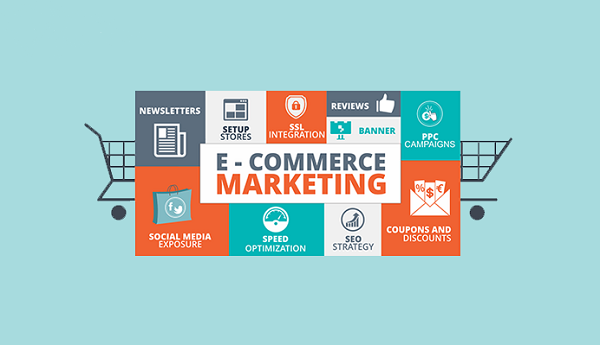Ecommerce Marketing: Connect With Your Customers
Nowadays, coming up with something completely innovative in business really does seem like a daunting task. So, your train of thought should be different – it is not always necessary to try to be innovative, but instead to think of ways to connect with the existing customers.
Why this connection is so important? One of the main reasons lies in the fact that connecting with your customers on an emotional level means that they are more willing to recommend you. With the relocation of business mainly to the Internet, opportunities for this are even wider.
Naturally, this brings up the question of how to do this. How do you attract new customers and keep the old ones? Which eCommerce marketing techniques are there, and which should you use?
Get to know your customers
Ecommerce marketing means using online channels to promote your e-store and products to customers.
The end goal is to help you sell more.
But, what does eCommerce marketing consist of and how does it work in practice? Simply put, it drives more traffic to your online store and helps you convert that traffic into leads and those leads into sales.
To do this, you need to know your target audience and then decide on a relevant strategy tailor-made for that specific audience. Based on their characteristics you’ll choose some of the many available marketing channels. There is no need to waste your time, energy, and ultimately money in using all the channels at once.
You can always start with a few marketing channels that you think are most relevant. After you find your way around those, then you can consider expanding your eCommerce marketing activities if necessary (and possible).
1. Connect with your customers on social media
Let’s start with the most popular way of making use of eCommerce marketing – using social media. Engage with your customers on social platforms such as Facebook, Linkedin, Twitter, and Instagram. Easier said than done, right? Well, let us shed some light on this matter.
There are a few things that you need to have in mind. First of all, maybe you don’t need to use all of those platforms. You’ll come to that conclusion if you do the first step of your eCommerce marketing investigation correctly – get to know who and where your customers are.
Not every business is suitable for every platform, and your targeted audience most likely is not present in all possible channels. When you become sure of where and to whom you need to present your business, the next step is to work on your social presence.
In the beginning, this might seem like an easy task, but as time passes, you’ll see that it will require more and more time and consistency. Having consistency is one of the most important things when it comes to engagement on social media. Whether you are just sharing relevant articles, writing your one, or doing something else, it is important to do it regularly. You can not post something and then just disappear for months, or not be responsive to your clients’ comments or inquiries.
Furthermore, consistency is not just about your posting schedule. It’s also about your brand’s tone, visual appearance, and responsiveness, among other things. This could include adding a link to your digital business card in your profile bio or within strategic posts.
Another important thing is to investigate when is the right time to post something on a specific platform. For that purpose, you can always use analytics that will also give you an insight into which eCommerce marketing strategy is performing the best.
The bottom line however is that, in the beginning at least, you will have to experiment a bit. This way you will be able to get a feel for what your audience will respond positively to, and what they may not like as much.
2. Content marketing
When you aren’t a pioneer in your industry, you might think that everyone has already told everything that needs to be told and that there is nothing new to add. But, that is not completely true, and you should not neglect this kind of connection with customers. There is always something that you might be able to explain better than your competition, or in a more engaging way.
Nowadays, when knowledge (academic and non-academic) is so multidisciplinary there is so much space for you to shed some new light on a topic if you approach it from a different perspective. Of course, your blog doesn’t need to be always like this. You can always use it to inform your audience about your company’s upcoming events or share some new information about new projects.
Also, having a blog is tightly related to your activities on social media. So as you can see, there are plenty of ways to incorporate different tools into your eCommerce strategy.
Besides writing a blog, you can also include some video content if it seems relevant – for example, show different ways of using the product, and by that increase customer satisfaction.
3. Search Engine Marketing
- Sponsored search results;
- Product shopping ads;
- Local services ads.
4. Use Email marketing
One of the oldest forms of eCommerce marketing is email marketing. It sounds old-fashioned, outdated, doesn’t it? But it still works. If done right, email marketing will help you build long-term relationships with your loyal customers.
What is different in email marketing today is that email can automatically be sent to people on your email list. You can use lead generation software to build this list and get more leads for your email marketing efforts. Automated emails would be sent after a certain trigger such as joining your list (welcome email), shopping cart abandonment (reminder), buying a product (recommendation for a complementary product), etc.
Did you know that, according to Marketing Land, “Personalized emails deliver six times higher transaction rates” but for some reason, only 30% of the companies use them? Personalization is important, and at the same time not so difficult to achieve. You could, for example, personalize the subject line and also address the receiver by his first name. Another possibility is to use the personal data that you’ve gathered so you can inform your customers when there are discounts that they could be interested in, or just to wish them a happy birthday.
5. The importance of having a good About Us page
As important as it is for you to get to know your customers, them being able to get to know you is equally important. When thinking in terms of eCommerce marketing, many companies don’t prioritize their About Us page. If their About Us page is boring according to the visitors, then that train of thought is most likely valid.
But it doesn’t have to be like that.
Providing a good background company story can be incredibly beneficial. About Us page is your space to share your vision, causes that you care about and why are they important to you. You could also use it to present your team members and in that way contribute to reaching a higher level of personalization. There’s plethora of ideas, you just need to be creative and think about what’s appropriate for your business and your audience.
Even though the end goal in all marketing fields, including eCommerce marketing, is to sell the product, it is not the only aim that should strive for. One of them also needs to be creating a long-lasting relationship with the customer. That is impossible to achieve if you don’t make time to create a proper eCommerce marketing strategy.
By using the right approach, you will show your customers that you listen to them and that their needs and comments are important to you. Then, you are on a great path to turning them into loyal customers.





